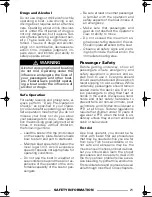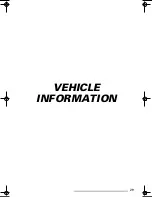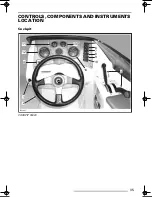
22
SAFETY INFORMATION
Operation by Minors
Minors should always be supervised
by an adult whenever operating a boat.
Many states have laws regarding the
minimum age and licensing require-
ments of minors. Be sure to contact
the state boating authorities for infor-
mation. BRP recommends a minimum
operator age of 16 years old.
Rules of the Road
As a responsible boater, you will com-
ply with the “Rules of the Road”, the
marine traffic laws enforced by the
U.S. Coast Guard. Navigating a boat is
much the same as driving an automo-
bile. Operating either one responsibly
means complying with a set of rules
intended to prevent accidents. Just as
you assume other car drivers know
what they are doing, other boaters as-
sume you know what you are doing.
Operating a boat can be compared
with driving unmarked highways and
roads. To prevent collisions or avoid
other boaters, a system of operating
rules must be followed. It's not only
common sense... it’s the law!
Check local and federal boating laws
applicable to the waterways where
you intend to use your boat. Learn the
local rules of the road. Know and un-
derstand the applicable navigation sys-
tem (such as buoys and signs).
Know the waters in which the boat is
to be operated. Current, tides, rapids,
hidden obstacles, wakes and waves
etc. can affect safe operation. It is not
advisable to operate the boat in rough
or inclement weather.
Remember these Rules
of the Road
Know the Right of Way Rules
Generally keep to your right and safely
avoid other craft by keeping a safe dis-
tance from other craft, people and ob-
jects.
CROSSING
Give right of way to craft ahead and to
your right. Never cross in front of anoth-
er craft.
RED light (give way to the other craft).
GREEN light (you have the right of way).
MEETING HEAD-ON
Keep right.
PASSING
Give right of way to other craft and keep
clear.
Navigation System
Navigational aids, such as signs or
buoys, can help you identify safe wa-
ters. Buoys will indicate whether you
should keep to the right (starboard) or
to the left (port) of the buoy or to which
channel you can continue. They may
also indicate whether you are entering
a restricted or controlled area such as
a no wake or speed zone. They may
also indicate hazards or pertinent boat-
ing information. Markers may be locat-
ed on shore or on the water. They can
also indicate speed limits, no power
craft or boating, anchorage and other
useful information. (The shape of each
type of marker will provide assis-
tance).
Make sure you know and understand
the navigation system applicable to
the waterways where you intend to
use the boat.
Collision Avoidance
– Do not decrease throttle when try-
ing to steer away from objects. You
need throttle to steer.
– Always keep a constant lookout for
other water users, other craft or ob-
jects, especially when turning. Be
alert for conditions that may limit
your visibility or block your vision of
others.
lmo2005-007a_1.book Page 22 Wednesday, September 1, 2004 3:27 PM
Summary of Contents for Challenger*180
Page 1: ......
Page 10: ...SAFETY INFORMATION 9 SAFETY INFORMATION ...
Page 29: ...29 VEHICLE INFORMATION ...
Page 77: ...77 MAINTENANCE INFORMATION ...
Page 99: ...99 WARRANTY INFORMATION ...
Page 130: ......
















































